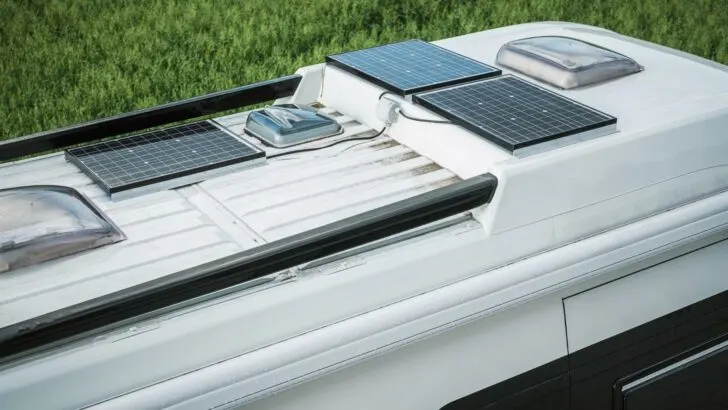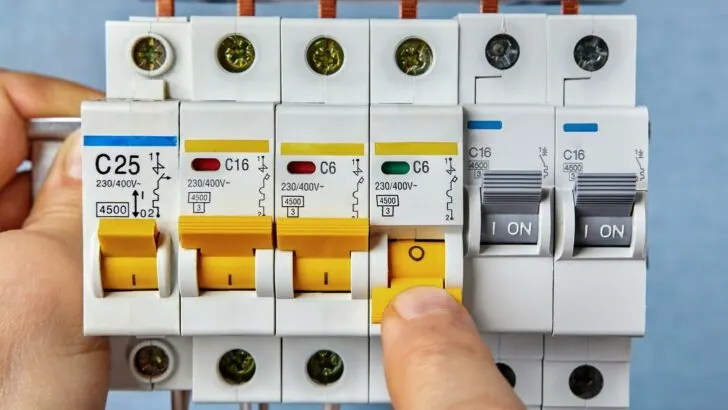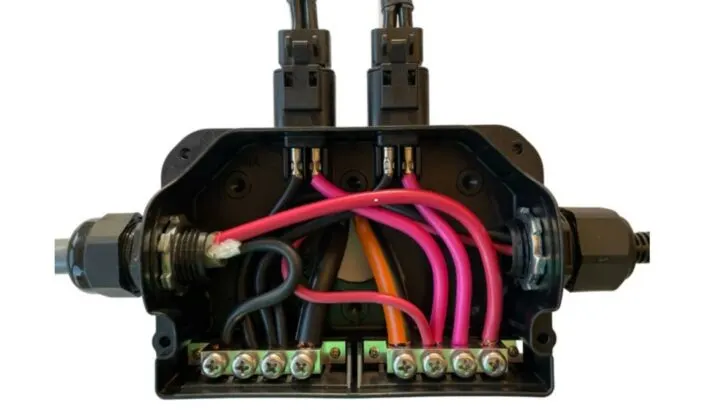If you’re adding solar to the roof of your RV, there are a number of components to consider. The best way to efficiently combine solar components on your rig’s roof is to use a solar rooftop combiner box. This will keep the rooftop connections safe from the elements and performing optimally.
In today’s post, we’re talking about using these boxes for the purpose of combining solar panel wiring with charge controller wiring. We’ll discuss what they are, how they work, and why they’re important to the overall integrity of your RV’s solar system.
What Is a Solar Rooftop Combiner Box?
A solar combiner box is essentially a junction box used to make waterproof connections between the wires coming from your RV’s solar panels and the wires leading to your solar charge controller.
They combine the rooftop solar cables efficiently while also sealing off the roof penetration into the RV, keeping everything water tight.
The solar combiner box on your RV roof is like the electrical junction box in a house except that it’s designed for the type of wiring used in solar/photovoltaic systems. And of course, it’s weatherproof. It houses several wires and cables entering from different ports and joins them tightly to bring the output of several solar strings together.
So the purpose of the combiner box is to combine several solar panels or strings of solar panels into a common bus.

A combiner box brings together several solar panels or strings of solar panels into a common bus.
Are All Solar Combiner Boxes the Same?
No. Some solar combiners are simply a box with “glands” (waterproof ports that allow the wires to pass through the walls of the box).
Other combiner boxes include a certain number of busses (connection points) for various sizes of cables, grounding wires, fuses/circuit breakers, and strain reliefs which provide a liquid tight seal for the positive and negative leads.
With some boxes, you can even purchase extra bus bars to combine additional solar (or to add a second system) using the same combiner box.
All of this helps to facilitate connecting the wires efficiently, but not all solar combiner boxes are the same.
In general, you’ll want a box that not only accommodates the wiring of your system but is also strong and waterproof, and offers UV protection so the box doesn’t degrade from sun exposure.
These are the most typical types of solar combiner boxes for RVs:
- Fused
- Non-fused
- Dual fused
- Pre-wired
- Boxes with circuit breakers
- Multi-String
What Are Common Components of a Solar Roof Top Combiner Box?
Let’s take a quick look at the various components that may be part of a solar combiner and their purposes.
Enclosure
The enclosure is the box that holds the combiner components.
Busbar
A busbar is an essential component of a combiner box. It’s a metal strip (or “rail”) that acts as a multi-connection point. The busbar is what allows us to integrate several incoming wires into a single component. Typically, a busbar combines the incoming negative or ground leads from solar panels.
The panel output wires are also connected to the busbar, joining the incoming and outgoing connections.
Terminal strip
A terminal strip functions similarly to a busbar but is typically constructed of ABS composite instead of metal.
Circuit Breaker

A circuit breaker is designed to protect an electrical circuit from surges/overcurrents or short circuits.
A combiner box may also house circuit breakers, which are switches that isolate a circuit and opens/disconnects it in the event of a surge or short circuit.
In solar combiner boxes, we typically see single-conductor or single-pole circuits. This means they only have a single set of contacts for use with an incoming wire.
Circuit breakers may also be located inside the RV, as opposed to being installed in the box.
Fuse
Similar to a circuit breaker, a fuse’s job is to disconnect a circuit in the event of a surge or short circuit. The difference between the two is that fuses depend on a tiny filament (wire) that blows when the rating of the fuse is exceeded. In doing so, it isolates or disconnects the problematic circuit.
Some types of fuses can be manually removed from the circuit and replaced.
A solar combiner box can also have other types of devices for surge protection and DC disconnects.
As with circuit breakers, fuses may also be located inside the RV, as opposed to being installed in the box.
Grounding Wire
RV solar panels need to be grounded. Otherwise, when you connect to shore power the electricity running through your RV can shock you whenever you touch an appliance.
Every type of RV electrical system must be grounded. A solar system is no different.
Do You Need a Combiner Box for Solar Panels?
Depending on your setup, you may not need a combiner box – but it may still be a good idea.
Remember that the box not only serves to tightly join the output cables of your solar panels but also serves to seal off the roof penetration which is incredibly important to prevent RV roof leaks.
Even if you have a simple solar system, spending a modest amount on a combiner box designed for small or medium-sized systems can offer excellent protection for the wiring and connections on your expensive solar system – and for your considerably more expensive RV.

This is the inside of a Zamp Roof Combiner Box (C-Box) for small to medium-sized RV rooftop solar arrays. (Photo credit: AM Solar)
Alternatively, if you’re planning a larger solar system, the combiner box linked below is a waterproof 4-string combiner box with lots of protection including lightning arrest, a 10a fuse, reverse-current protection, and circuit breakers.
With this model, you could combine up to 4 solar panels wired into the box’s bus with the wires that run through the roof and into your charge controller (as long as the current and voltage of a single panel don’t exceed the rated maximums).
This not only makes the appropriate connections securely, but it also provides protection to your system as well as to your RV roof.
- 【Easy installation】With mounting buckle, no key needed to open and close the box, very easy to use. Suit for any regular surface. Plug and...
- 【500V 63A PV DC Circuit Breaker】ECO-WORTHY 4 String PV Combiner Box has 500V 63A PV DC Circuit Breaker, 10A pv current fuse and 9AWG cables....
Just Getting Started with Solar?
If you’d like a bit of a primer on RV solar, we invite you to check out our general post on RV solar panels followed by the post that covers the distinctions between flexible solar panels vs rigid.
Especially important is our post on the RV solar charge controller.
If you’d like to dive a little deeper, in the video below John explains our 1,300-watt RV solar system that combines rigid and flexible panels and uses power tilt kits from SolaRVector.
Geek Out with Us Every Week
Join our newsletter to learn about all things RV-related. Every week we offer free tips, tricks, product reviews, and more to our online community of RVers. So, whether this is your first time on the road or you’re a seasoned expert, we’d love for you to geek out with us!


